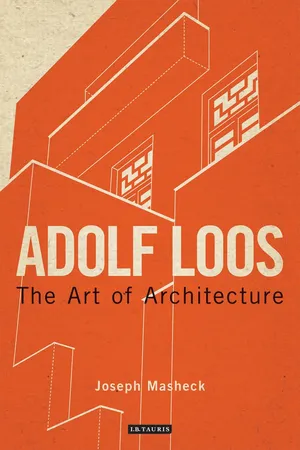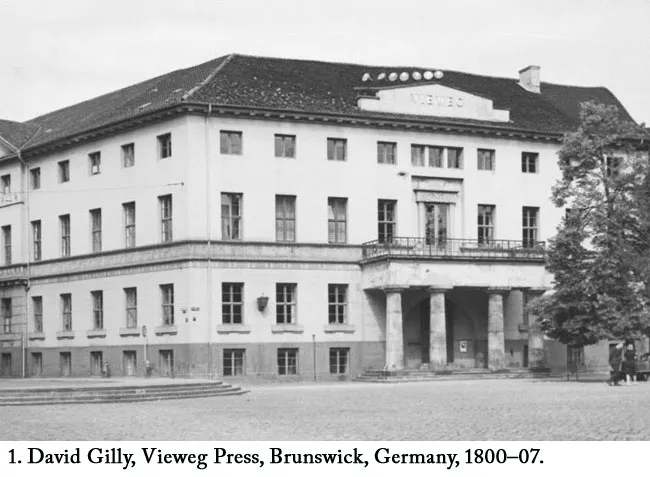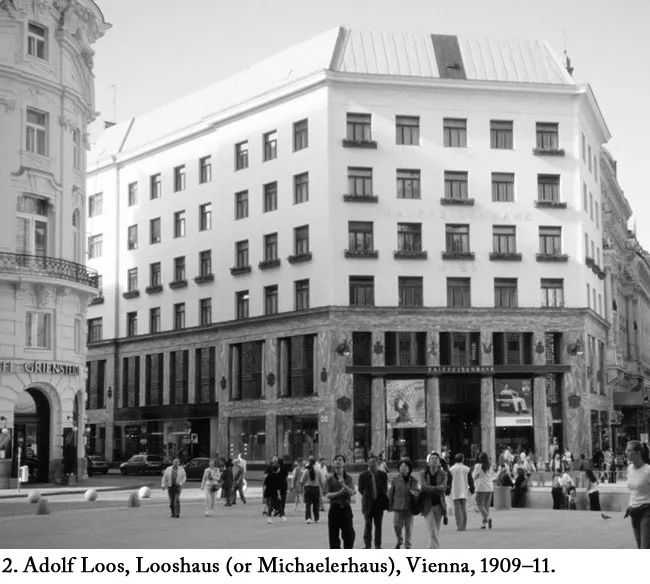1
LOOS AND FINE ART
A new overview, reappraising and reinterpreting Adolf Loos (1870–1933) can begin and perhaps end with questions of art and artlessness. For the work of this early modern architect, in theory and practice, is often enough taken as only an extreme case of nihilistic early modern iconoclasm, out to deny art as such and prove all the braver for it. Ironically, Loos is often made to sound like a Marcel Duchamp of anti-architecture even though, ironically enough, he is somehow also cast as a patron saint of ultra-rational architectural functionalism. Different in theory but likewise negative is also a persistent view of the Viennese Loos as happily heartless architectural counterpart to the Vienna Circle of ‘logical positivists’ in philosophy, with its summary nullifications of whatever might be accused of not being empirical as hopelessly metaphysical – that circle from which Ludwig Wittgenstein, having in some measure made it possible, walked away. Scandalously enough, Loos did make something in the order of a claim that architecture, or, rather, the private house, should not be a matter of art; though as with Nietzsche, it would be dangerous to lose track of the ironist’s twists. Rather than contend with the terms of the nihilistic view we might seek to open up the question by teasing out Loos’s artfulness, taking Loos more artistically seriously in a variety of aspects.
Misconstrual of Loos has only worsened now that being all too well known an artist has come to imply being a media ‘star,’ identifiable by performing a role in an art world that is a realm of entertainment rather than by producing notable works of art. Here Loos himself does not help his case by having been a bon vivant who liked creating a stir while managing not to ruffle the basic persona of a scrupulously groomed Anglophile (and Ameriphile) variety of the turn-of-the-century artist dandy. And as far as the art of architecture, specifically, was concerned, some ambiguity was inevitable. It had long seemed a commonplace that what made a mere non-art building into a work of architectural art was the superaddition of ornament borrowed from one or another canonical historical style (Greek, Roman, Byzantine, Gothic, Renaissance, Baroque, Neoclassical), when Loos came along and claimed that such a conception was an affront to urbanity. The sophisticated modern city-dweller should know better: applied ornamentation, like tattooing, should be evidence of low civility. Surely it was wrongheaded to think that ornament was what made an otherwise unqualified building architectural art: if anything, in modern times ornament was vain and vulgar.
In line with William Morris in theory, if not with the Viennese ‘Secession’ as offshoot of the Morrisonian Arts and Crafts movement, for designer-artists to be handing over to craftsmen ‘artistic’ designs for servile execution, no matter how up-to-date, signaled the ruination of craft traditions which had otherwise held artistic authenticity. A valid architecture should be like unselfconscious, unpretentious, local vernacular building, the praises of which are sung in his text ‘Architecture’ (1910). No wonder confusion set in about it being a fine thing for a building to amount to art, and about what, if anything, was to be the role of an architect who agreed with what Loos was saying.
His signature building as architecture-as-such
Vital to the question of Loos as artist-architect is the case of his signature building, known as the ‘Looshaus,’ on the Michaelerplatz in central Vienna, designed in 1909 and built in 1910–11. It is true that in the time of this building he was already calling into question in ‘Architecture’ whether architecture as such, as some say, or at very least whether a house, ought to be conceived as a work of architecture and hence as a work of art. For the time being, we can accept Loos’s ‘masterpiece,’ with the Goldman & Salatsch men’s tailoring emporium on the lower two floors and private apartments above, as at least eligible to be counted as architecture. After all, a collective apartment house may have at least the dignity of an individual house (one might even say, ‘of many mansions’).
Because this heroic upstart of a modern building has stood like a bulwark against the notion that pseudo-historical ornamentation is what qualifies a building to count as architecture and hence art, and its author as an artist-architect, it seems to have been all too embroiled in ritual controversy and insufficiently regarded as enmeshed in art history as a work of art. Evidence is ample of the work’s artistic affiliations, ignored in the standard approach to the building, with its classy urban tailor shop below and supposedly brutishly fenestrated apartment walls above. Loos himself seems to have enjoyed the metropolitan scandal, at least as what he would have called an English ‘good sport.’ Now that the building is a century old we may be able to assess it more fairly as the textbook masterpiece it became – first of the modern as true, good, and beautiful, during the mid-twentieth century, later for essentially literary postmodern cultural generalization.
Suppose it is true, first of all, that the emperor, whose imperial front door it faced, disliked looking at the Looshaus’s supposedly ever so radically plain upper stories, which Loos himself once reputedly likened to vernacular plainness. Well, then it is also true that the plainness of those upper stories was hardly different from the plainness of the fenestration – which is to say, the disposition of the windows in a façade – along prominent stretches of courtyard within the precincts of his own palace, notably the east end of the court between the Imperial Chancellery wing and the Leopoldine wing. As a matter of fact, just such plain fenestration, with grids of windows having few or no frames, can be seen as a nice old Goethezeit, Neoclassic-to-Biedermeier thing, as traditional as neatly pressed linens (as the eighteenth-century scientist and writer Georg Lichtenberg is sometimes invoked for in his sheer aphoristic critical terseness as anticipating Karl Kraus or Wittgenstein).
Instead of thinking of the Looshaus as rudely and artlessly interjecting the horrid modern world into charming Vienna, let us try thinking instead of the Looshaus, as it rose, politely keeping its counsel about a certain gross stylistic anachronism across the way. For though the ‘Michaelertrakt,’ as that wing of the palace is called, with the great entrance portal to the Hofburg, was designed by Josef Emanuel (son of Johann Bernhard) Fischer von Erlach in the early eighteenth century, nobody had actually gotten around to building it until 1889–93, when it must have looked more revivalist than authentic. To exaggerate for emphasis: the moment the Looshaus went up facing it across the square, as a perfectly decent modern counterpart to the plainer stretches of the palace, the Michaelertrakt should have blushed for looking like a young person dressed in vintage clothes. The trouble was, everybody except the moderns was in on the historical charade of, in this case, ‘Late Baroque Classicism.’ Only because charades of the kind were precisely what was meant at the time by architectural art did Adolf Loos make a point of negating all such talk. Fortunately, modern art, including architecture and even this particular building, was coming into its own historical conviction. So when we hear Loos, in the same moment as the Looshaus, seemingly denying architecture the status of art, we ought to keep the polemical circumstances in mind.
Purportedly it was the shamelessly unadorned simplicity, as if undressed, of the unrelieved, gridded fenestration of the whole upper façade that had everybody in a stir. A well-known journalistic cartoon could liken it to a flipped-up storm-drain grate in the street in front of it only because, to most people, it looked ignobly lacking in the bourgeois grandeur that made for serious architecture, architecture worthy of the name. But despising historicism – the parasitic dependence on historical stylistics – is not the same as denying art history. Besides the overlooked affinity with other parts of the supposedly offended Hofburg, the building has quite decent art-historical ancestors in its own right. There is an urbane similarity between the façade of the Looshaus, with its plain upstairs, with recessed Roman Doric porch between two converging streets, and the walls with evenly spaced square windows bending back left and right from a rounded corner with recessed Roman Doric porch, in Baldassare Peruzzi’s (Mannerist) Palazzo Massimo alle Colonne, in Rome, begun in 1532. That is a valid if relatively arcane art-historical point, if not all there is to the case, especially in view of the nearness in time as well as Central European space of the earnestly simple Biedermeier.1
Again, the burghers of 1910 really must have wanted to have their tantrum of rejection because the Looshaus could easily have been welcomed on proto- or quasi-Biedermeier terms as happily akin, for instance, to a certain classicizing commercial building with chaste Doric porch, built likewise on the corner of a tapering site a century earlier in Brunswick (Braunschweig), Germany, by David Gilly, teacher of the famous ultra-classicist Karl Friedrich Schinkel: the publishing establishment Vieweg Verlag, of 1800–07 (the firm, which left Brunswick only in 1974, published a book on Loos’s Müller House in Prague, by Christian Kuhn, in 1989). Gilly was a major architect belonging to that restrained, so-called ‘Zopf’ tendency in Middle European culture c. 1800, named after women’s tight hair braids of ‘upright’ connotation: the cultural set-up, in a sense, for the Biedermeier. Gilly’s building, too, was dual-purpose, if not so private/public disjunct as tailoring and housing: as an industrial and office building housing both printing and publishing functions. Formally, the volumetric articulation of the three-bay central portal of Gilly’s long flank with flush doorway and flanking windows below, all without disturbing the smooth façade plane, has a Loosian ring. A large, typically Gillian but also pre-Louis-Sullivanian, sweeping semicircular arc, here somewhat hidden behind the portico on the building’s shorter side, would also one day cut smartly through the otherwise quite regimented fenestration of a late Loos hotel project of 1931. With such art-historical connections available, making a scene for publicity might even save the cause of art.2
Beyond Biedermeier overtones, the wider stylistic relations of the Looshaus (artistic style being intrinsically a matter of art) are richer than its usual characterizations allow – the question of art as style, and style as ornament, being itself not as simple as a mere presence (below) or absence (above) of classical columns. There is not only a significant British feature, sometimes acknowledged, but a relevant American parallel of overall form, all the more significant after Loos’s direct experience of early modern Chicago architecture, including a major possibility of Sullivan from outside Chicago. On the first point: the inset bay windows of the second floor (American style; ‘first floor,’ European), are accepted as reminiscent of the British Victorian ‘oriels’ referred to by Loos himself (“English bow windows”; OA 96). In aspects of disposition, the Looshaus has been seen to compare with two recent American office buildings with which Loos might have acquainted himself in Chicago, namely, S. S. Beman’s Studebaker Building (now Fine Arts Building), of 1884, and The Rookery, 1885–66, by Burnham and Root (Czech and Mistelbauer 108). Apropos of the latter, Frampton sees “two-storey inlaid columnar peristyle” of the Looshaus entrance façade as “a simplified version … of the very similar treatment devised by Burnham and Root for the street-level façade of their Rookery Building” (Frampton, ‘In Spite’ 216). Loos would have understood that he was, if anything, returning to Burnham and Root’s thinking before they took on the dubious job of imposing Imperial Roman classicism throughout the World’s Columbian Exposition – which Loos had come to America to see – except, ever so notably, for Louis Sullivan’s Transportation Building (by then already demolished).
Particularly Sullivanian, however, seems the crisp, unmodulated conjunction of cylindrical-columnar and boxy-beam forms in the lower, commercial part of the Looshaus, with, between the shorter bay windows of the entrance wall, each square pier between bays answering a column immediately beneath. This disposition follows an uncannily similar interplay of round and squared elements at the ground and first floor of Sullivan’s Guaranty Building, in Buffalo, New York, of 1894–95. Loos was interested in Sullivan; and when Rudolf Schindler, one of his two most famous disciples who emigrated to America (the other being Richard Neutra) tried unsuccessfully to help Sullivan publish his Kindergarten Chats in Austria or Germany, between 1918 and 1922, Loos, in 1920, thought that possibly the Quakers of Vienna might be able to help (see McCoy). Sullivan parallels which have already been noticed include his Union Trust Company Building, at St Louis, 1892–93, and a Loos project of 1925 for an office building on the Boulevard des Italiens, in Paris, whose eleven storeys of unframed windows between a plain tall ground floor and a columned top are unabashedly reminiscent of the Looshaus (illus., Sekler 262, 263).
The Looshaus does seem to fascinate those who would rather engage with avant-garde scandal than with architectural art, and can deal with the idea of Loos’s antiornamentalism but might be confused in the thick of things by Sullivan’s American critical revisionist sense of ornament as hardly an all or nothing affair. In actual fact, the building never stood completely blank, even before the city fathers obliged Loos to add windowboxes on the front (which he did, in simple form but of bronze). Curiously, radical though it is, the Looshaus is one of those shake-up modernist masterpieces which prove surprisingly respectable, once invited into the serious art-historical canon, by an artist who may have spoken against the oppression of architectural historicism but who made art history...


